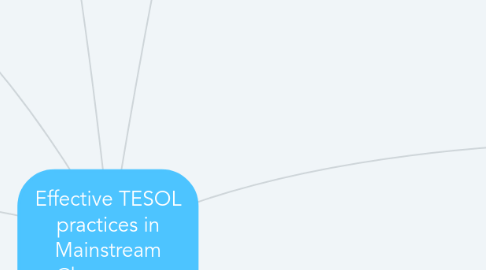
1. 4
2. 5
3. Code Switching Practices
3.1. Allowing students to utilise both languages allows the to develop and maintain identities of both cultures.
3.1.1. Able to participate and belong to communities that use either language.
3.2. Allows for language fluidity, promoting bilingual language fluency.
3.3. Learning how to communicate in real life settings, not solely classroom practices.
3.4. Allows multiple definitions of a 'good learner'
3.5. Less effective/sort after by more affluent families with the belief of proper English is important for better jobs.
3.6. Provides opportunities for students to explore deeper workings of language and power structures.
3.7. Facilitates students critical language awarness
3.8. English Only methods do not demonstrate a higher english development in learners
3.9. Students and teachers develop a view of Native language as learning tool
3.10. A more inclusive practice
3.11. code-switching pedagogy is meaningful and inclusive in creating a language learning environment that is sensitive to diversity, knowledge production, institutional constraints, and tensions in language education.
4. 7
5. 8
6. TESOL Programs run in schools
6.1. Pull-Out Programs
6.1.1. Ineffective
6.1.2. Cheapest/Easiest for Schools to implement
6.1.3. Students are removed from mainstream classroom, missing work, to improve English skills
6.1.4. Leaves Students confused when re-entering classroom
6.1.5. Teachers feel ESL teacher should do more to have students up to speed
6.1.6. ESL teachers believe classroom teachers need to do more to incorporate students in the classroom
6.1.7. ESL teachers work with all children across all year levels that need help each day, they have limited time with students
6.1.8. Classroom Teachers have to cater for entire class of students not just ELL students
6.2. Push-In Programs
6.2.1. ESL teacher comes into classroom to work with students
6.2.2. ESL teacher assist students complete classroom work, not separate work on langauge
6.2.3. Limited ESL teachers and resources
6.2.4. ESL teachers have their own instruction/agenda for students
6.2.5. ESL teachers would then be required to have a knowledge of the curriculum and work for every class and grade in their school
6.2.6. Often ESL teacher works with students in corner of room, rather than assisting with adjusting to whole class.
6.3. Collaborative/Team-Matching Models
6.3.1. Team Teaching between mainstream classroom teacher and ESL teacher
6.3.2. Minimal documented research on this practice
6.3.3. Study performed in a school on this method
6.3.3.1. 20% of Student population Chinese immigrants
6.3.3.1.1. Families unable to provide support with school work due to minimal English knowledge
6.3.3.2. Supportive administration staff
6.3.3.2.1. Work with faculty to attempt to assist both them teaching ELL students and to benefit the ELL students
6.3.3.2.2. Meetings - How ESL teachers and classroom teachers could work together to benefit ELL student literacy and English development
6.3.3.3. Minimal resources
6.3.3.3.1. Previously tried pull-out and push-in programs due to this
6.3.3.4. Year long study with year 4 teacher and ESL teacher working collaboratively. Assisted by university researcher
6.3.3.4.1. ESL teacher - 2 years experience
6.3.3.4.2. 4th grade teacher - 3 years at this school
6.3.3.4.3. University Research - Literacy Consultant - Focus for 2 years of ELL learning
6.3.3.4.4. Teachers collabarated
7. Teaching Pedagogies
7.1. Negative Pegagogies
7.1.1. Strict English Only
7.1.1.1. Native language not a resource for student learning
7.1.2. Strip away native language and culture for new western/english culture
7.1.3. Basic inclusion of native culture (surface elements), included because of policy, not for student benefit.
7.1.4. Blame student for lack of engagement, not content/teaching
7.1.5. English only resources displayed in classroom
7.2. Positive pedagogies
7.2.1. Relationships with resourceful and caring adults
7.2.2. Students feel safe, secure, and suppourted
7.2.3. Understanding, respecting, and reflecting native cultures, protocols, and interactions
7.2.4. Teacher uses native language where possible and appropriate.
7.2.5. Validating native culture
7.2.6. Native language is a resource to student learning
7.2.6.1. Able to code-switch in discussions.
7.2.6.1.1. Students choose when to use english and native language, trusted in their ability to choose appropriate times.
7.2.6.2. Students more responsive to inclusive practices
7.2.7. Native language resources displayed throughout classroom through student work and artefacts, such as flags and sports team memorabilia.
7.2.8. Use of topics of interest for students
7.2.8.1. Ask them what they would like to learn about
7.2.8.2. Allow students to select from assign texts what topics to study.
7.2.8.3. Take 'picture walk' through resources to assist in peeking interest, select character they desire to learn about
7.2.9. Allows students to be engaged in and enjoy English learning.

